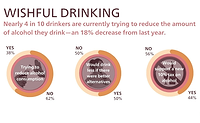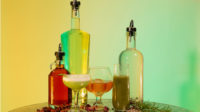Ready-to-drink, low/no alcohol categories on the rise
Market research vital for future innovations success

Image courtesy of CANTEEN Spirits
If you’re heading out for some summer fun, and think about grabbing a few ready-to-drink (RTD) adult beverages for convenience — you certainly will have more options than ever before in today’s world. There’s been a renaissance of RTD adult beverage products developed in the past 10 years, well beyond our erstwhile party favorites from the 1990s and early 2000s like Mike’s Hard Lemonade and Smirnoff Ice (who remembers getting “Iced”?!). While those well-known lines have significantly expanded, offerings in this space continue to evolve as consumer sentiments around functional ingredients, product wellness attributes, and attitudes toward alcohol shift. This category is transforming at a rapid pace into a new beast altogether.
Ready-to-drink is expected to boom in North America in the coming years, with a projected $43.6 billion for the global RTD beverage market by 2027, according to a Data Bridge Market Research study. Although the convenience of pre-mixed beverages is surely an aspect of this category’s boom, other intersecting factors like the sober curious movement, expansion of CBD infused beverages and usage in U.S. markets, and cross-categorical turn toward healthy offerings have had just as much of an impact on RTD’s explosive growth.
The recipe for RTD offering success in today’s market is a dynamic one, responding equally to global health sentiments, consumer drinking habits, and the ever-evolving palette of today’s consumer. Consumer market research into the beverage landscape and among the target consumer audience is an absolute requirement for those seeking to gain headway. Here’s a sneak peek at some of the key factors impacting brand success in this expanding market:
Millennials race toward ready to drink
In 2021, BevAlc Insights partnered with online beverage retailer Drizly to forecast RTD trends for the year ahead. They found that millennials represent the overwhelming share of the category (62%) and skewed decidedly female. Liz Paquette, Drizly’s head of consumer insights, noted that, “younger generations have seen the most share growth in this category over the past few years as it has evolved from primarily multi-serve margaritas to a wide array of single-serve cocktail flavors.”
But what’s really driving these consumers to RTD at such a rapid pace? Although we might be quick to presume the trend is a pandemic fad, contributors to the report remind us that growth was projected for this category before the pandemic hit. The ISWR echoed this finding, noting that 2020 consumption rates were in-line with 2019 trends, and they point instead to the success of offerings like hard seltzers and canned cocktails whose convenience, price point, lower calories and flavor options appeal directly to millennial consumer demand.
Mollie Cook, the director of marketing for Denver-based Molly’s Spirits, similarly attributes the success of RTD offerings with millennial consumers to a nuanced balance of quality with cost.
“RTDs have evolved from basic, low-ABV drinks to true, high-proof cocktails,” she shares. “In the past, all that was readily available was usually-too-sugary Margarita mix. Now, we see a massive variety that encompasses everyone’s tastes. … The wide variety also allows consumers to experiment with new types of cocktails without purchasing the ingredients needed to make them at home.”
When it comes to getting this ratio of right, smart brands looking to enter the RTD space will need to look for gaps in the category while working directly with consumers in real-time to develop offerings that deliver on quality and taste — and offer healthier alternatives — without breaking the bank.
Gen Z sets sights on sobriety
Much of the current success being experienced by brands in the RTD space have Gen Z’s moderate outlook on alcohol consumption to thank.
Gen Z consumers are more likely than other adult beverage consumers to prefer mocktails and CBD-infused beverages, and that they are choosing alcohol beverages remarkably less often than their millennial counterparts, with a significant six point differential between the two groups according to a Numerator study.
Beverage executive Paul Beaupre spoke with SKU in 2021 about the rise of RTD mocktails, particularly amongst younger drinkers. He shared that he felt Gen Z drinkers “want to be ready for activities; there is not as much of a stigma of not drinking compared to older generations. They are also experimenting with other options in place of alcohol. And they may want to avoid negative social media exposure.”
Brands like Ghia, Curious Elixirs and Kin Euphorics have capitalized on the “good vibes” drinking-age Gen Z consumers seek, coupling wellness ingredients and marketing with Instagram-worthy packaging to appeal to younger consumers seeking a spirit-free RTD experience. This leads to another significant consideration to make when targeting Gen Z consumers: drinking age adults in this category are 45% more likely to learn about new beverage brands through social ads than millennials. This shift to digital communications presents a need for novel approaches to marketing and consumer communication, taking into account your product’s market share side-by-side with your slice of real estate on potential consumers’ social feeds. Product forecasting can help producers in this space predict the obstacles they’ll face on the road ahead.
Functional ingredients and single serve for the win
Our ongoing study shows two-in-five Americans are interested in low- or no-alcohol beverages, with mocktails and RTD beverages topping the list. But what really sets these contemporary offerings apart from their more alcohol-forward ancestors comes down to what’s inside.
Functional ingredients like CBD, vitamins, antioxidants and adaptogens reign supreme and elevate the humble mocktail to health status, appealing doubly to an overarching demand for wellness offerings across age groups and global lines. But don’t just trust us: EHL Insights recently named CBD-infused drinks the top drink trend in 2022 with fermented drinks ranking third on the list, and a FoodDive.com article from earlier this year ranked functional ingredients as the second most influential trend across food and beverage categories.
Earlier this year, we wrote for Beverage Daily, elaborating on the functional ingredient trend as well as the intersecting factors leading to its meteoric rise. We found that, while consumers are asking for healthier beverage options across the board, functional ingredients truly need to deliver on their claims to appeal to today’s health conscious consumer. With so many functional ingredients out there, products can employ pre-launch market research approaches like discovery research, claims testing and message testing to understand what your consumers are looking for from the functional ingredient trend.
RTD beverages also are riding the wave of consumer demand when it comes to packaging, specifically single serve and sustainably sourced solutions.
Looking just at low-no offerings, our research found that 53% of Americans seek ready-to-drink options and overwhelmingly single serve glass or can options when doing so. But it isn’t as simple as reducing your packaging size. Health-conscious consumers want to ensure their products take sustainability as seriously as they say they do.
Once again, brands will need to study human behavior to understand how to establish the right marketing messaging both on and off RTD packs. By examining consumer response, you can ensure that you are effectively communicating your brand’s ethos and captivating consumer interest in a now somewhat crowded space.
Crossing the finish line
With so many factors contributing to success in the RTD adult beverage category, it might feel overwhelming. Thankfully, it doesn’t look like we’ll be seeing an end to the trend anytime soon. Offerings on the upswing as of late include ranch water, a tequila-based seltzer cocktail whose light caloric content and authentic taste have taken the RTD adult beverage category by storm.
Reflecting on the innovation of this Texas bar-favorite into RTD, Drizly’s Liz Paquette notes that, “few other categories saw more growth over the past few years than ready-to-drink (RTD) cocktails, driven by consumers’ desire for high-quality, easy-to-enjoy, highly portable cocktails.”
Ranch water might be RTD product a la mode today, but the innovation and potential within this category promises fresh offerings for years to come — and ample opportunity to participate. Conducting market research to understand where your brand can pivot in this quickly growing and changing category, how your RTD product can best resonate with consumers, and where to fulfill marketplace need will be essential to success.
Looking for a reprint of this article?
From high-res PDFs to custom plaques, order your copy today!






